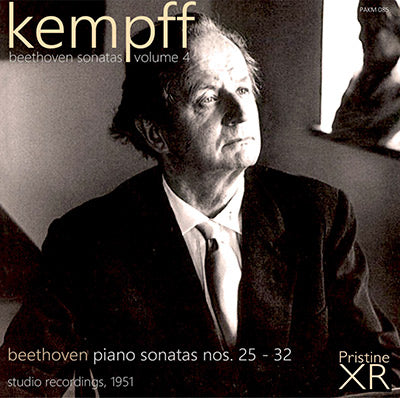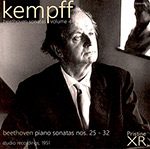
This album is included in the following sets:
This set contains the following albums:
- Producer's Note
- Full Track Listing
- Cover Art
Wilhelm Kempff is in the front rank of Beethoven players, and in the “Hammerklavier” only Horszowski and Backhaus (of the pianists listed above) can compete with him. Kempff is an intellectual, as opposed to Gulda, who relies almost entirely on his phenomenal technique. He is less impetuous than Horszowski or Appelbaum, notably in the first and last movements, and I think myself he is a little too restrained in the opening pages of this sonata. The tempi of this first movement is anybody's guess; Kempff chooses rather a slow one and the music is interesting enough but a little unexciting. He really comes into his own in the slow movement, which he takes at a less leisurely tempo than most people, showing an absolute grasp of its structure and its poetic content. I found his playing most moving, and I do not think I have heard a better performance of either this movement or the fugue. He takes the latter very steadily, and constantly surprises by bringing out details of part-writing that I (in company with the pianists listed above) had not noticed before. He has firm, controlled finger technique, and seems never in any danger of smudging the more difficult passages. The piano quality on this record is excellent, better for instance than on the Backhaus disc. If you want a more dashing performance Horszowski is your man, but I am inclined to prefer Kempff. In every way this is a very fine record.
R. F., The Gramophone, April 1956
[The recordings] are taken from the first cycle German pianist Wilhelm Kempff made of the Beethoven sonatas during the LP era (most were recorded in the early 1950s). That monophonic cycle was first issued in the United States on Decca. A DG stereo Beethoven piano sonata cycle followed in the mid-1960s. Both are marvelous collections, documents of one of the great Beethoven pianists of the 20th century. There is a famous anecdote told by Kempff about his visit to the home of Jean Sibelius toward the close of the Finnish composer’s life. Sibelius asked Kempff to play the Beethoven “Hammerklavier” Sonata. “When I have finished, [Sibelius] says to me: ‘You did not play like a pianist, you played like a human being.” Kempff was of course more than equal to the considerable challenges Beethoven, a great virtuoso in his own right, presented in his solo piano writing. But in his performances of Beethoven (and all the other composers he championed), Kempff always placed his technical gifts at the service of the music. Kempff’s Beethoven is unfailingly elegant in tone. Voices are presented with the utmost clarity, rubato is sparingly and tastefully applied, and Kempff is ever attentive to Beethoven’s frequent dynamic gradations. Still, Kempff’s Beethoven never lacks for vigor and energy.
All of these laudable elements are evident in both the early-1950s and mid-1960s sonata cycles. Wilhelm Kempff was in his mid-50s when the mono recordings were made, and about 70 for the later cycle. The musicianship on both sets is exemplary, but the earlier cycle finds Kempff closer to the zenith of his technical abilities. Up until now, the stereo cycle has had the upper hand from a sonic perspective. A comparison of the 1995 DG issue of the mono cycle with the label’s 2019 release of the stereo remake reveals the former to possess somewhat cramped sound, with a bit of compression in louder passages. However, the Pristine Audio XR restoration of the monophonic recordings constitutes a dramatic improvement. They now emerge with a striking clarity, depth and beauty of tone, and impressive dynamic range. In fact, the mono recordings as restored by Andrew Rose and Pristine Audio are at least competitive with the stereo cycle, and might have offer a bit more satisfying sound. If Pristine Audio can maintain this level of achievement throughout the remainder of the cycle, it will be a tremendous and important achievement indeed. Marvelous recordings, now presented in superb sound; recommended with enthusiasm.
Ken Meltzer, Fanfare magazine, January-February 2021, review of Volume 1 of this series (edited)
KEMPFF The Beethoven Piano Sonatas, Volume 3
DISC ONE
BEETHOVEN Piano Sonata No. 25 in G major, Op. 79
'Cuckoo'
1. 1st mvt. - Presto alla tedesca (3:02)
2. 2nd mvt. - Andante (2:29)
3. 3rd mvt. - Vivace (2:05)
Recorded 22 September 1951
BEETHOVEN Piano Sonata No. 26 in E-flat major, Op. 81a
'Les adieux'
4. 1st mvt. - Das Lebewohl. Adagio - Allegro (6:52)
5. 2nd mvt. - Abwesenheit. Andante espressivo (2:59)
6. 3rd mvt. - Das Wiedersehen. Vivacissimamente (4:24)
Recorded 24 September 1951
BEETHOVEN Piano Sonata No. 27 in E minor, Op. 90
7. 1st mvt. - Mit Lebhaftigkeit und durchaus mit Empfindung und Ausdruck (5:09)
8. 2nd mvt. - Nicht zu geschwind und sehr singbar vorgetragen (8:19)
Recorded 21 September 1951
BEETHOVEN Piano Sonata No. 29 in B-flat major, Op. 106
'Hammerklavier'
9. 1st mvt. - Allegro (8:55)
10. 2nd mvt. - Scherzo. Assai vivace (2:41)
11. 3rd mvt. - Adagio sostenuto (15:22)
12. 4th mvt. - Introduzione. Largo - Fuga: Allegro risoluto (11:53)
Recorded 25 September 1951
DISC TWO
BEETHOVEN Piano Sonata No. 28 in A major, Op. 101
1. 1st mvt. - Etwas lebhaft und mit der innigsten Empfindung. Allegretto ma non troppo (3:35)
2. 2nd mvt. - Lebhaft. Marschmäßig. Vivace alla marcia (5:41)
3. 3rd mvt. - Langsam und sehnsuchtsvoll. Adagio, ma non troppo, con affetto (2:38)
4. 4th mvt. - Geschwind, doch nicht zu sehr, und mit Entschlossenheit. Allegro (7:13)
Recorded 25 September 1951
BEETHOVEN Piano Sonata No. 30 in E major, Op. 109
5. 1st mvt. - Vivace ma non troppo, sempre legato - Adagio espressivo (3:14)
6. 2nd mvt. - Prestissimo (2:24)
7. 3rd mvt. - Gesangvoll, mit innigster Empfindung. Andante molto cantabile ed espressivo (11:09)
Recorded 20 September 1951
BEETHOVEN Piano Sonata No. 31 in A-flat major, Op. 110
8. 1st mvt. - Moderato cantabile molto espressivo (6:06)
9. 2nd mvt. - Allegro molto (2:29)
10. 3rd mvt. - Adagio ma non troppo - Fuga. Allegro ma non troppo (9:41)
Recorded 20 September 1951
BEETHOVEN Piano Sonata No. 32 in C minor, Op. 111
11. 1st mvt. - Maestoso - Allegro con brio ed appassionato (7:06)
12. 2nd mvt. - Arietta. Adagio molto semplice cantabile (14:40)
Recorded 20 September 1951
Wilhelm Kempff, piano
XR remastering by Andrew Rose
Cover artwork based on a photograph of Wilhelm Kempff
Recorded at Beethovensaal, Hannover
Total duration: 2hr 30:06
CD1: 74:10 CD2: 75:55

